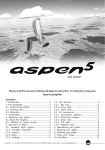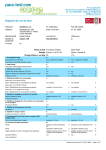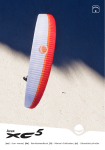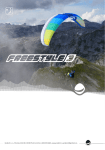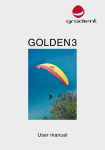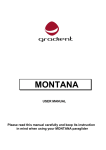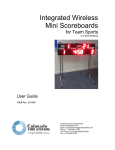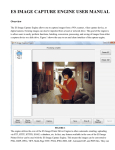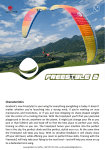Download Bright5 user manual
Transcript
[en] - User manual, [de] - Betriebshandbuch, [fr] - Manuel d’utilisation, [cz] - Uživatelská příručka [en] User manual Please read this manual carefully and keep its instruction in mind when using your Bright5 paraglider Contents: 1. Introduction......................................................1 2. Your paraglider...............................................1 2.1. Technical description....................................1 2.2. Technical data..............................................2 2.3. Materials........................................................2 3. Certification......................................................3 4. Adjusting your glider ..................................3 4.1. Brake-line lengths......................................3 4.2. Addition of speed system.........................4 5. Operation in flight.........................................4 5.1. Standard flight regime..............................4 5.1.1. Pre-flight inspection................................4 5.1.2. Launch........................................................4 5.1.3. Flight...........................................................5 5.1.4. Landing......................................................5 5.2. Fast descent..................................................5 5.2.1. Big ears.......................................................5 5.2.2. B-line stall...................................................6 5.2.3. Spiral dive.................................................6 5.3. SIV maneuvers..............................................6 5.3.1. Asymmetric collapse.................................7 5.3.2. Full-frontal collapse..................................7 5.3.3. Deep stall...................................................7 5.3.4. Full stall.....................................................7 5.3.5 Negative spin............................................7 6. Maintaining your glider..................................8 7. Checking your glider........................................9 8. Repairing your glider.........................................9 9. Enjoy your flying............................................10 10. Line Map........................................................11 Gradient s.r.o., Plzenska 221/130, 150 00 Praha 5, tel+fax +420257216319, www.gradient.cx, [email protected]. 1. 1. Introduction Congratulations on buying your new Bright5 – GRADIENT’s latest basic intermediate wing. We believe you will be very happy with your new glider in terms of its flight characteristics, exceptional safety and really nice handling. The Bright5 is a basic/intermediate paraglider (category EN/LTF-A) and is therefore meant for the widest flying public: from new pilots to time-served pilots – anyone in fact who wants high performance but also exceptional safety from their paraglider. This manual provides information which will help you fly safely and keep your wing in good condition. If, after reading this booklet, you have any further questions or are uncertain about anything, please do not hesitate to contact Gradient or any authorised Gradient dealer. We will gladly answer all your questions. When you have got to know your Bright5 we would welcome any feedback that you might have about your new paraglider. 2. Your paraglider 2.1. Technical description The glider’s profile has been specially developed to deliver maximum stability over as wide a speed range as possible. The design and camber of the central curve in the glider give maximum resistance to the collapse of the leading edge. The position and size of the cell openings help support this objective. The leading edge is reinforced using integrated nylon and elastic. This ensures optimal inflation of the canopy and helps to retain the leading edge’s perfectly clean shape at maximum speed. The well-proven three-and-half-rows and three-riser line concept with progressively differing diameters is used – a system Gradient has uses for years. Careful selection of lines and materials means the wing-loading is optimised in flight in any situation. Progressive line diameters along the span and chord are already standard in Gradient wings. The Bright5 is supplied with a three-riser speed-system with two pulleys and working range of 10cm, which gives great acceleration and maximum speed. The main C-lines are connected to the karabiners through loops, allowing for easier adjustment when your glider is serviced. Optimal cell opening sizes and position ensure efficient air intake at a very wide angle of attack The Bright5 is the other Gradient glider where we have used Everlast, a new double-coated Porcher material. Everlast was developed by Gradient in co-operation with Porcher Sport, and this exclusive material provides gliders with long-term stability and durability. Small, simple details make this glider complete. Gradient has paid attention to details too, including: clearing holes on the wing tips; split A-risers with special karabiners; and a new rucksack, inner bag and riser bag. 2. Fig 1: Length of the Bright5 risers (mm) Size 22 A1, A2 B C Non-accelerated 440 440 440 Accelerated 355 367 440 Size 24 A B C Non-accelerated 460 460 460 Accelerated 370 383 460 Size 26 A B C Non-accelerated 480 480 480 Accelerated 385 399 480 Size 28 and 30 A B C Non-accelerated 500 500 500 Accelerated 400 415 500 2.2. Technical data Bright5 Units 22 24 26 28 30 Flat Area m2 22.06 23.88 26.77 29.48 32.14 Projected area m2 18.70 20.24 22.70 24.99 27.26 Span m 10.31 10.73 11.36 11.92 12.44 Projected span m 8.29 8.62 9.13 9.58 10.01 Aspect ratio 4.82 4.82 4.82 4.82 4.82 Projected aspect ratio 3.67 3.67 3.67 3.67 3.67 2.63 2.74 2.90 3.04 3.18 40 40 40 40 40 Maximum chord m Number of cells Line consumption m 264.9 275.5 291.8 306.2 319.7 Weight of the glider kg 4.1 4.5 4.9 5.3 5.7 Take-off weight range* kg 54-66 63-80 75-100 90-115 105-135 A A A A A Certification EN / LTF 2.3. Materials Canopy Fabric Finish Weight Upper sail-leading edge Skytex 40 Everlast 40 g/m2 Upper sail-rear part Skytex 38 Universal 38 g/m2 Bottom sail Skytex 38 Universal 38 g/m2 Ribs+Diagonals Skytex 40 Hard 40 g/m2 Reinforcements Scrimm F02 420 X15A 180 g/m2 Reinforcements 060981450YET001 Laminated 60 g/m2 Reinforcements Hahl Nylon 6, 2/1200 Ø 2 mm Gradient s.r.o., Plzenska 221/130, 150 00 Praha 5, tel+fax +420257216319, www.gradient.cx, [email protected]. 3. Lines Finish Diameter Strength Material Cousin covered 1.0 mm 100 daN Dyneema/PES Edelrid covered 1.1 mm 100 daN Dyneema/PES Edelrid covered 1.3 mm 130 daN Dyneema/PES Edelrid covered 1.4 mm 160 daN Dyneema/PES Edelrid covered 1.3 mm 140 daN Aramid/PES Edelrid covered 1.5 mm 190 daN Aramid/PES Edelrid covered 1.8 mm 240 daN Aramid/PES Edelrid covered 2.0 mm 280 daN Aramid/PES Risers Fabric code Width Strength Material 15 mm 850 daN PAD 22 mm 1250 daN PAD Al Webbing Webbing Pulleys Parafly Pulleys Karabiners Rilay PAD Maillon Rapide Ø 3.5 mm 750 daN Steel 3. Certification All sizes of the Bright5 are certified EN-A and LTF-A. The certification certificate on your Bright5 is found on a rib in the middle of canopy. Certification is valid for ABS type harnesses. This type of harness enables a certain degree of adjustment to be made to the length of the chest strap. The recommended distance between the karabiners is 44-48 cm. In common with all other paragliders, when looser cross-bracing is used while flying the Bright5, the pilot’s weight-shift control is greater. The glider is also more sensitive to movement in the surrounding air. When cross-bracing is tighter, the pilot feels subjectively more stable, but turning by weight-shift is practically ineffectual. WARNING: The Bright5 paraglider is only built for hill or tow launching. It is not built to withstand jumping from a plane, balloon, building or for any jumps where there is a belated opening of the canopy. 4. Adjusting your glider Before it reaches the customer every Bright5 goes through a final check and test-flight to verify that its characteristics and measurements correspond to the manufacturer’s specifications. You may only make adjustments to brake-line lengths or to the speed system of your Bright5 and only then in keeping with the recommendations of this manual. Other adjustments or changes to your Bright5 lead to a loss of guarantee, airworthiness and validity of the certification. Amateur modification may endanger yourself and other pilots. If you do have any suggestions for improvements let us know and our test pilots will try out your ideas without risk to yourself. 4.1. Brake line adjustment When you receive your new Bright5 the brake-line length is adjusted to be the same as that used during the flight tests. This length should suit most pilots and is indicated on the main control line. It is of course possible to adjust the brake-line length to suit each pilot’s physical 4. build, height of harness hang points, or style of flying. We recommend that you act wisely when adjusting brake-line length and change the length in small, successive steps. If you need to adjust brakes back to the basic position and the marks on the main brake lines are vague, use the following lengths: Bright5 22: 212 cm; Bright5 24: 220 cm; Bright5 26: 234 cm; Bright5 28: 245 cm; Bright5 30: 256 cm. Brake lines that are too short may: Lead to fatigue from flying with your hands in an unnatural position Impede recovery from certain unstable maneuvers Will certainly reduce your glider’s speed range Brakes that are too long may: Hamper pilot control during launch Reduce control in extreme flying situations Make it difficult to execute a good flare when landing. Each brake line should be tied securely to its control handle. Use knots that guarantee this, for example, a Double Dragon. 4.2. Adding a speed system The Bright5 is equipped with a foot-operated speed system as standard. Pressure on the foot stirrup shortens the A and B risers and by this, reduces the angle of attack of the canopy. The working range of the speed system pulleys is 11cm. Make sure you can use the whole of this range when you attach your speed stirrup. For some pilots this will require the use of a two-step speed stirrup. 5. Operation in flight This manual is intended as a guide to the characteristic features of your new Bright5 paraglider. Under no circumstances should it be used as a ‘learn-to-fly’ manual for paragliding or as a substitute for a training course. 5.1. Standard flight 5.1.1. Pre-flight check A thorough pre-flight check is essential for safe flying and that’s why you should pay special attention to it. Above all, you should check that the canopy, lines and risers are free from damage and tangles. Also don’t forget to check your harness and your reserve parachute. Before launch spread the canopy out in a slight arc and check that: All cell openings are free No lines are looped around or under the canopy No lines are tangled or have a knot in them Any twigs, grass or other objects are not tangled in the lines or the canopy Risers are not twisted Control lines run freely through the pulleys Knots on control handles are secure Carabiners on risers are tightened 5.1.2. Launch Launching the Bright5 is straightforward, either by forward (Alpine) or reverse launch. A dynamic pull on the front risers (A, coloured red) will bring the canopy simply and easily above the pilot’s head. The canopy inflates from the centre equally and smoothly. The Bright5 has no tendency to outrun the pilot and quickly stabilises above the pilot. Once there, visually check the canopy and the lines before take off. Take off can be made easier by a light pull on the brakes. Gradient s.r.o., Plzenska 221/130, 150 00 Praha 5, tel+fax +420257216319, www.gradient.cx, [email protected]. 5. 5.1.3. Flight The Bright5 is trimmed to fly at best glide when the brakes are fully up. Best sink rate is achieved when both brake lines are drawn down evenly to about 20-25% of their range. Turbulent conditions When flying through severe turbulence stabilise the canopy by simultaneously applying a little brake to both sides. Flying with a little brake applied will also help to prevent deflations and give you more feedback about what the air is doing and how the glider is reacting. Responding correctly to the paraglider’s movement by means of the brakes and weight shift is known as ‘active flying’. A pilot demonstrating good active-flying skills will significantly reduce both the number and severity of collapses he or she experiences. Turning The Bright5 is very comfortable and pleasant in turns. Handling characteristics are responsive and accurate and demand no special habits or non-standard procedures. When developing the Bright5 special attention was devoted to the brake pressure. The result is that brake travel and pressure have been optimised. Brake pressure is reassuringly progressive. In flight, brakes are firm but responsive and precise and allow for perfect communication with the canopy. You will find that a harness with fairly loose cross-bracing will help the glider turn. In an emergency (eg a broken brake line) the glider can be steered with the rear risers or by weight shift. Using the speed system Maximum speed is one of the strong points of Gradient paragliders and the Bright5 is no exception. Not only has the glider got a very high maximum speed, but unlike some other paragliders the full speed range is useable. In spite of this exceptional stability at high speed don’t forget that any collapse at full speed will be more severe than the same event experienced at normal trim speed. Always keep both hands on the controls when flying fast in turbulence and be ready to release the speed system immediately at the first sign of a collapse. Use the speed system very carefully or not at all at low altitude. 5.1.4. Landing Landing the Bright5 is very simple and should offer no difficulty. On your first flights you may be surprised at how well it glides. Take account of this when making your landing approach! Into wind, at about one metre above the ground pull the brakes down all the way. In nil-wind conditions, or if forced to make an emergency landing downwind, you may prefer to take a wrap of each control line to enable a more dynamic flare. 5.2. Rapid descent Practise these maneuvers under the supervision of an instructor and with a reserve parachute. Never compromise your safety. Sooner or later every pilot will need to descend quickly. It might be because of a sudden and unexpected change in the weather, reaching cloud base and not wishing to enter cloud, or simply because you need to finish your flight quickly. Additionally, if where you are landing is thermic, it is often very difficult to land without using a rapid descent method. There are three main methods for achieving a rapid descent and they are: Big Ears, B-Line Stall and Spiral Dive. 5.2.1. Big Ears This is the easiest technique for a rapid descent. Depending on how much of the wing tip you deflate, 3 m/s to 6 m/s sink rate can be achieved. While in Big Ears your sink rate and forward speed can be further increased by using the speed system. The Bright5 is equipped with split A-risers for easier Big Ears. The glider can be steered while Big Ears are in by means of weight shift. 6. Initiation: Take hold of the outer A-lines on both sides as high as possible and pull them down smoothly. Hold them firmly. The effective area of the glider is reduced equally on both sides of the wing. The size of the deflated area depends on how deeply the lines are pulled down (or on the number of lines pulled – one or two outer lines on both sides). Be sure to pull both sides equally. Recovery: Under normal circumstances the Bright5 will open automatically when the A-lines are released. Opening may be accelerated by gently pumping the brakes (repeated symmetrical braking on both sides). 5.2.2. B-Line Stall This is a very effective rapid descent technique. Depending on how far the B-risers are pulled down, the sink rate is between 5 m/s and 10 m/s. Initiation: Take hold of the B-risers at the top and smoothly pull them down until the canopy shows a span-wise crease where the B-lines attach to the canopy. Your sink rate will increase considerably while your forward speed will decrease to practically zero. Don’t be startled when the airflow over the top surface is disrupted and the paraglider enters a parachutal stall without moving forward. It will soon stabilise above your head. Recovery: On releasing the B-risers the Bright5 automatically returns to normal flight without staying in deep stall or surging in front of the pilot. Let go of the risers smoothly and symmetrically. Caution: Do everything symmetrically and at the same time. If the B-risers are released unevenly the canopy can enter a turn. If the risers are released slowly and very unevenly you could enter a spin. 5.2.3. Spiral Dive The Spiral Dive is the most effective way of making a fast descent. Every pilot should be able to perform a spiral dive and one day you may need to. When in a Spiral Dive always stay aware of your altitude, which decreases very rapidly. The sink rate reached in a Spiral Dive can be more than 14 m/s. During the manoeuvre the pilot and glider will experience strong centrifugal forces. Forces of greater than 3G are possible – a great strain on the pilot as well as the glider. Initiation: Smoothly pull on one brake so that the glider goes from a normal 360-degree turn into a steep turn and from there into a spiral dive. The transition into a spiral dive can be made easier by weight shifting to the inner side of the turn. Keep an eye on the tension of the brakes all the time: reduced tension signals an overload of the glider and danger of falling into a negative spin. Recovery: The Bright5 recovers from a Spiral Dive automatically as soon as the brakes are released. Release them smoothly and always finish a Spiral Dive with safe altitude. Caution: When exiting the Spiral Dive make sure your position in the harness is neutral. Recovery from a Spiral Dive can be delayed if you are weight shifting to the inside of the turn. 5.3. SIV maneuvers No matter what category of canopy you fly or what level of certification it has, in turbulence or in strong thermals you may experience all kinds of collapses. The Bright5 behaves comfortably in these situations. Indeed, not only does the glider deal with extreme flight situations automatically, but it also offers an above-average degree of safety. Even so, you must follow all safety rules when practising SIV. Always pay attention to your altitude. Before performing any SIV maneuvers remember: • Practise throwing your reserve on the ground, in a simulator, so that reserve deployment is efficient and automatic. Gradient s.r.o., Plzenska 221/130, 150 00 Praha 5, tel+fax +420257216319, www.gradient.cx, [email protected]. 7. • Rapid altitude loss and considerable rotational forces may develop during unstable maneuvers. Take account of this when throwing your reserve. 5.3.1. Asymmetric Collapse – one side of the canopy collapses Initiation: Take hold of the outer A-lines (outer A-riser) on one side and pull them down smoothly. The wing tip will collapse to form a characteristic Big Ear. The size of the ear depends on the depth to which the lines are pulled as well as the number of lines pulled down. You can stop any turn tendency by applying the opposite brake and by weight shifting onto the inflated side of the canopy. Recovery: Under normal conditions the Bright5 will re-inflate spontaneously when the pulled lines are released. Inflation time and loss of altitude can be reduced by suitable piloting. To stop any tendency to turn off course pull the brake on the inflated side (be careful not to overreact and stall the inflated side) and weight shift to that side. If the collapse remains then re-inflate the collapsed side by ‘pumping’ the brake on the collapsed side. 5.3.2. Full Frontal Collapse Initiation: Take hold of both A-risers at the top and pull them down until the leading edge collapses. Recovery: In normal conditions the Bright5 will recover normal flight automatically as soon as the front risers are released. Applying the brakes on both sides simultaneously can help re-open the paraglider 5.3.3. Deep Stall Initiation: Pull both brakes smoothly until the sink rate increases markedly and the forward speed reaches almost zero. The pull on the brakes should be controlled so that the canopy stays inflated and doesn’t fall back into a full stall. Recovery: The Bright5 cannot stay in deep stall flight, so after the brakes are released the glider automatically returns to normal flight. If you need to, you can accelerate recovery by pulling hard on both brakes, followed by a fast release. Or you can pull lightly on the A-risers. Caution: If you pull too hard on the A-risers you may experience a full frontal collapse. 5.3.4. Full Stall Initiation: Wind the control lines once or twice around your hands and pull both of them down smoothly. Hold them down until the canopy falls behind the pilot and deforms into a characteristic crescent shape. Hold your hands firmly (press them underneath the seat) and be careful that you do not release the brakes prematurely or asymmetrically. Recovery: The Bright5 recovers from a full stall automatically after the brakes are smoothly released. During correct recovery from a full stall the Bright5 shows no extreme tendencies such as a diving in front of the pilot. If the brakes are released prematurely or too quickly there is a possible tendency for the glider to dive ahead of the pilot. This can be corrected by adequate simultaneous braking on both-sides. Caution: When exiting a Full Stall if the brakes are released asymmetrically the glider may suffer a massive asymmetrical collapse followed by a tendency to enter a spin. 5.3.5. Negative Spin Initiation: Slow down by braking to nearly minimum speed. Then pull a brake on one side all the way down while simultaneously releasing the brake on the other side. Because the stalled side falls back, the canopy suffers airflow disruption over one half of the wing which results in a spin and a rapid loss of altitude. 8. Recovery: Under normal circumstances the Bright5 is capable of recovering from a negative spin automatically when the brakes are released. Caution: In general when there is a very fast or a long-lasting rotation and when the brakes are released too quickly, the canopy may shoot in front of the pilot followed by a massive asymmetrical collapse. WARNING: Whenever a paraglider is not in normal flight and airflow is disrupted there is always a rapid increase in sink rate and therefore a substantial loss of altitude. When practising SIV, the wrong manoeuvre at the wrong time may change a fairly easy situation into a dangerous problem. You are also exposing your glider to forces that may damage it. Practise SIV maneuvers only under the supervision of an instructor and with a reserve parachute. 6. Maintaining your glider If you handle your glider with care and store it in a suitable place it can last you a very long time. However, neglecting maintenance, bad storage and the use of unsuitable cleaning products can reduce the lifespan of your glider significantly or may even make it dangerous. Observe these rules: • Choose a suitable area for your launches. Lines caught on roots or rocks lead to unnecessary strain on the attachment tabs during inflation. Snagging lines may rip the canopy tissue or damage lines. • Never let the canopy fall on its leading edge. The effect of these forceful collisions and the sudden pressure increase can severely damage the air-resistant coating of the canopy as well as weaken the ribs and seams. • Protect the canopy from unnecessary strain. Inconsiderate handling of your glider – pulling it over grass, soil, sand or rocks – will significantly reduce its lifetime and increase its airporosity. • When preparing the paraglider for a launch or when ground handling, be sure not to step on any of the lines or the canopy. • Don’t tie any unnecessary knots in the lines. Packing methods where special knots are made in the lines as used on parachutes and reserve parachutes are not suitable for packing the lines used on paragliders. • Protect your canopy and lines from unnecessary exposure to sunlight. UV-rays can damage many parts of a paraglider. • Try not to pack your glider when wet. If it’s unavoidable then dry it as soon as possible away from direct sunlight. Do not store it wet – this is the most common reason for cloth degradation and is easily preventable. • In case of seawater, rinse with fresh water and dry before storing. • When storing always use the inner protection sack. • When storing or during transport make sure your glider isn’t exposed to temperatures higher than 50 degrees Celsius. • Never use chemicals on the glider. Clean it with clean lukewarm water only. • For long-term storage pack the glider loosely and store in a cool, dry and well-ventilated room. • After tree - or water-landings always examine the glider carefully. If you suspect that the flight features of your paraglider have changed, contact an authorised Gradient supplier as soon as possible. Gradient s.r.o., Plzenska 221/130, 150 00 Praha 5, tel+fax +420257216319, www.gradient.cx, [email protected]. 9. 7. Checking your glider After 200 flying hours or two years your Bright5 must be thoroughly checked and tested by the manufacturer or by a Gradient authorised service centre. This check is primarily focused on: • Measuring porosity • Measuring tear strength of fabric • Sewing of panels, attachment points, cell openings, etc. • Condition of lines and risers • Line strength • Geometry of the suspension system All data are recorded in the test report. On the basis of the real wing’s condition, the check expert can define the next check interval: under normal circumstances it is two years. 8. Repairing your glider Only small repairs, that is repairs that don’t change the airworthiness of the paraglider, may be done by the user. These include: fixing small tears (but not seams) up to 10 cm; changing damaged lines; and changing rubber line-fixation rings on the small karabiners. When repairing your paraglider on your own follow these rules: When repairing the sail use a self-adhesive patch specified for this purpose. Every Bright5 comes with a small amount of self-adhesive material, which is enough for small repairs. The only admissible repairs done on lines are those where the damaged lines are changed for new ones. Lines must be exclusively supplied by Gradient, an authorised dealer or authorised service centre. When ordering new lines use the codes in the attached line diagram. Use the code “B5” (Bright5) and tell us the size your glider, followed by the line code. For example, the outside long line in row A for a Bright5 28 is: ‘B5 28 A 1.3.’ An exception to this is an emergency repair while out flying. For this purpose Gradient encloses a spare line with every Bright5 with a prepared loop on one end. To get the right length adjust it according to the same line on the opposite side of the canopy and then, if necessary, attach your brake handle. As soon as you can, change the line for an original one from your authorised Gradient service centre. After changing any lines a thorough pre-flight check must be done. Don’t hesitate to ask your instructor or an experienced colleague for help. If you’re not sure, entrust the job to either the manufacturer or an authorised Gradient dealer. 10. 9. Enjoy your flying Even though the Bright5 has outstanding performance and stability it must be understood that even the safest paraglider is an aircraft and that all air sports can be relatively dangerous. Remember that your safety lies in your own hands and that, “Lucky pilots are well prepared pilots”. Never underestimate weather conditions. And never forget that you are flying for pleasure and not to become a ‘fallen hero’. Remember this and the fun that only free-flying can bring will be yours. We believe that your sensible attitude and the flight characteristics of your Bright5 will combine to ensure you have many hours of fantastic flying. GRADIENT wishes you many fabulous flights and happy landings. Ondřej Dupal Director Václav Sýkora Designer Gradient s.r.o., Plzenska 221/130, 150 00 Praha 5, tel+fax +420257216319, www.gradient.cx, [email protected]. Cyprián Koreň Designer 11. 10. Gradient Bright5 – Line Map Middle of the cannopy 3.1 3.2 3.3 3.4 3.5 3.6 3.7 3.8 Row A 2.1 2.2 2.3 2.4 2.5 1.3 1.3 3.1 3.2 3.3 3.4 3.5 3.6 3.7 3.8 B 2.1 2.2 1.1 2.3 C 2.1 2.5 1.3 2.2 1.1 2.3 D 2.1 2.2 2.5 1.3 R 1.1 R0 2.6 3.9 3.10 3.11 3.12 2.5 2.6 2.4 2.5 2.6 1.2 3.5 3.6 2.3 2.1 2.2 1.1 1.3 2.4 2.1 2.2 2.3 Brakes S 3.9 3.10 3.11 3.12 2.4 2.3 2.6 3.3 3.4 1.3 3.1 3.2 3.3 3.4 3.5 3.6 3.7 3.8 Row 3.9 3.10 3.11 3.12 2.4 3.1 3.2 3.3 3.4 3.5 3.6 3.7 3.8 Row 2.6 3.1 3.2 1.1 Row 3.9 3.10 3.11 3.12 2.7 2.8 2.9 1.3 [en] - User manual, [de] - Betriebshandbuch, [fr] - Manuel d’utilisation, [cz] - Uživatelská příručka














![[en] - User manual, [de] - Betriebshandbuch, [fr]](http://vs1.manualzilla.com/store/data/006912521_1-8302f7208a0db85345a8e06c74364fdf-150x150.png)
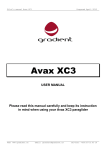
![[en] - User manual, [de] - Betriebshandbuch, [fr]](http://vs1.manualzilla.com/store/data/006911916_1-c9d681cd72beb3d6890eaa31d72ed1ef-150x150.png)

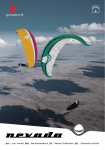

![[en] - User manual, [de] - Betriebshandbuch, [fr]](http://vs1.manualzilla.com/store/data/005845053_1-6d1995608e49c7f1600fcad0c20a630a-150x150.png)
